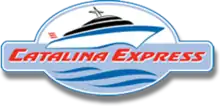Catalina Express
Catalina Channel Express is an American passenger ferry service that operates scheduled trips between Santa Catalina Island and mainland California.[4] The company began service in 1981 with a single sixty-passenger vessel.[2] As of 2016, the Catalina Express fleet includes eight high-speed vessels that can make the roughly 30 mi (48 km) channel crossing in under an hour.[2] Catalina Express controls 95 percent of passenger and freight traffic to and from the island when including its sister company, Avalon Freight Services.
 | |
| Type | Privately held company |
|---|---|
| Industry | Transportation |
| Founded | 1981 in California, US |
| Founders |
|
| Headquarters | San Pedro, California , US |
Number of locations | 5 |
Area served |
|
Key people | Greg Bombard (President) |
| Services | High-speed ferry transport |
Number of employees |
|
| Website | catalinaexpress.com |
| Footnotes / references [1][2][3] | |

Background
Catalina Express operates year-round, and runs up to thirty trips a day in peak season. Transportation is provided to ports at Avalon and Two Harbors on Santa Catalina Island from the mainland California cities of San Pedro, Long Beach and Dana Point. Catalina Express transports over one million passengers each year, and has transported over 25 million passengers as of August 2015. The most popular port of departure is the Catalina Landing in Downtown Long Beach, which provides the most daily trips. The company's San Pedro terminal underwent renovations in 2012, and is the only port to offer daily service to Two Harbors.
On April 1, 2016, Catalina Express and Harley Marine began a new sister company, Avalon Freight Services, from the Catalina Sea and Air Terminal in San Pedro. Avalon Freight Services operates self-propelled landing craft named Catalina Provider, and a rebuilt tug named Lucy Franco.
Catalina Express and Long Beach Transit have created a partnership which entails the Catalina Express vessel crews to operate and manage the vessels Aquabus and Aqualink around Long Beach Harbor and Alamitos Bay, with its year-round service.
Fleet
The company began with only one vessel that held about 60 passengers. As of 2019, the company operates eight high-speed vessels.[5]
| Name | Type | Length (Feet) | Passenger Capacity | Top Speed (Knots) | Crossing Time (Minutes) | Built |
|---|---|---|---|---|---|---|
| Catalina Jet | Catamaran | 144 | 450 | 37 | 60 | 1999 |
| Starship Express | Catamaran | 134 | 300 | 37 | 60 | 1999 |
| Jet Cat Express | Catamaran | 145 | 381 | 42 | 60 | 2001 |
| Cat Express | Catamaran | 97 | 360 | 28 | 60 | 1987 |
| Islander Express | Monohull | 97 | 149 | 32 | 60 | 1994 |
| Catalina Express | Monohull | 97 | 149 | 32 | 60 | 1994 |
| Super Express | Monohull | 95 | 149 | 32 | 60 | 1989 |
| Avalon Express | Monohull | 95 | 149 | 32 | 60 | 1990 |
See also
- Catalina Flyer, a competing ferry service to Catalina Island from Newport Beach, California.
- List of ferry operators
- List of HSC ferry routes
References
- Karen Gee-McAuley. "Catalina Express Fact Sheet" (PDF). Relevance Public Relations. Retrieved 24 May 2017.
- Karen Gee-McAuley. "Catalina Express - A Leader in Luxury" (PDF). Relevance Public Relations. Retrieved 24 May 2017.
In 1981, founders Doug Bombard, with son Greg and colleague Tom Rutter, formed Catalina Express. [...] The company, which employs 450 people in summer and 300 during the winter [...]
- "Ports: Catalina Express". Catalina Express. Archived from the original on 19 November 2018. Retrieved 19 November 2018.
- "How to get to Avalon, Catalina Island". Santa Catalina Island Company. Retrieved 26 September 2013.
- "About Us". Catalina Express. Retrieved 26 September 2013.
| Wikimedia Commons has media related to Catalina Express. |